Weaving is fun and rhythmic — once you have the loom set
up. And, you can’t really set up a loom until you
have the parameters of your project pretty well nailed up, including
the yarns for warp and weft, as well as the sett and specific threading
pattern. While you can vary the weft yarn once you’ve started, on
a typical loom you’re pretty much fixed for sett and threading pattern
once you’ve got the loom set up. And, depending on the particular
yarns, things can look very different in the pattern once you actually
start weaving — they rarely line up in tidy little squares like on
your graph paper!
I imagine that experienced weavers have a good sense of what threading
patterns will produce, and the various effects of different types
(thicknesses, composition, colours) of yarn with those
patterns.
I, however, I can only imagine, becauseam not an experienced
weaver! And, I found I was impeded in making progress on becoming
one when I could not figure out how a pair of yarns were going to play
together for my next planned project. I really didn’t want to get
into calculating warp lengths and number of warp ends unless and until
I had some sense of how the yarns would play together. So, I
stalled for several months.
Finally, I did a couple of things to break the logjam.
First, I ordered a weaving kit (Halcyon
Yarn’s Waffle Weave Dishtowels). It includes the
yarns you need, tells you what sett to use, as well as the
threading. So, it’s just execution: measure off 402 warp
ends in various colours, sley the reed, thread the heddles, re-thread
the heddles when you realize you made a mistake 1/4 of the way in
(sigh), tie up the treadles, and you’re good to go!
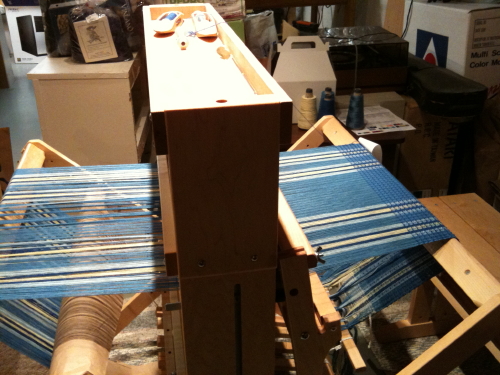
And, waffle weave is pretty! Perhaps others would understand it
intuitively from the pattern draft, but I had to actually weave by rote
for a bit before I could start to see how it was building up the
texture in the fabric:
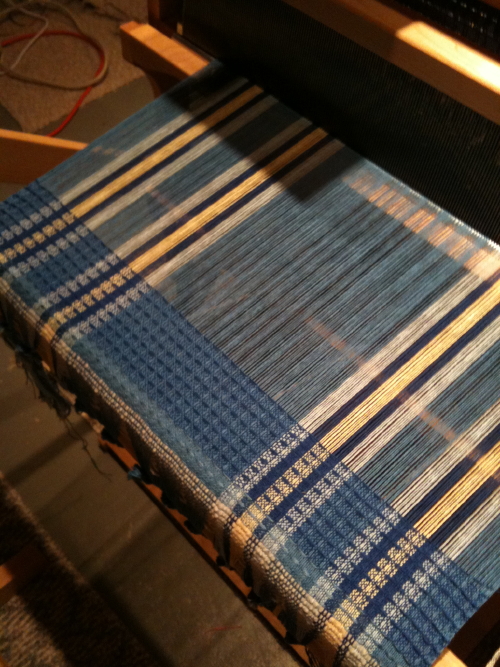
Given that it still took me a month of on-and-off work to get those
warp ends measured et cetera, it’s pretty clear it will be a while
before I’ll be an experienced weaver with the kind of “mind’s eye” for
pattern work that I describe above. I really wanted something I
can play with to see
the different possibilities with the yarn before I commit to a real
project.
So, the other thing I did was get a Northwest Pioneer loom.
This is a loom that is specifically designed to facilitate re-sleying
and re-threading mid-project. Here it is, still bolted onto
the base of its shipping crate. It’s a 15″ table loom, and to
keep that in perspective, the shipping box fit in the back seat of my
car. It’s a lovely bit of hand-worked solid maple — pretty!
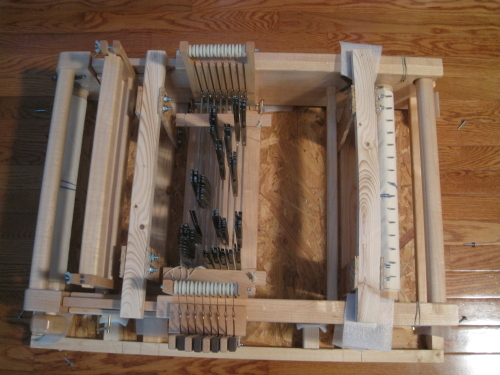
In terms of re-threading — note that the shafts in the picture above
have no “top”. The headles have a slit through which you slide
the yarn from the top — and which you can pull out and rearrange
(under loosened tension) mid-project. Likewise, you can remove
the top bar of the beater and re-sley the reed, for a different sett.
As an added bonus, it also supports
continuous warping. The pictures below show it with
its warping rails extended.
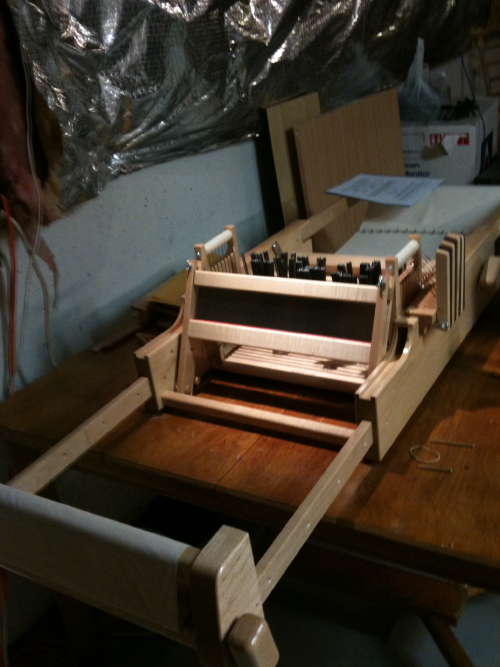
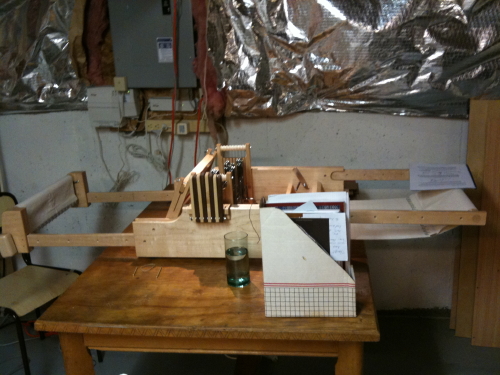
Errr, yes, pardon the lovely studio decor — my fibre equipment is
slowly taking over the basement, but we haven’t done anything to finish
it.
Within an hour or 2, I had it warped up and ready to roll, launching
into a twill pattern with the brown linen warp and variegated pink,
shiny acrylic yarn:
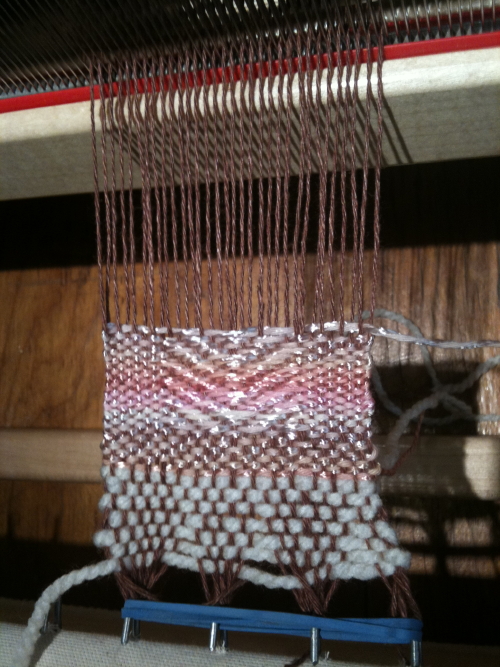
Among the things I would not have predicted accurately — the weft
dominance.
Satisfied with that experiement, I re-threaded the warp to a different
pattern, and test-drove it some more:
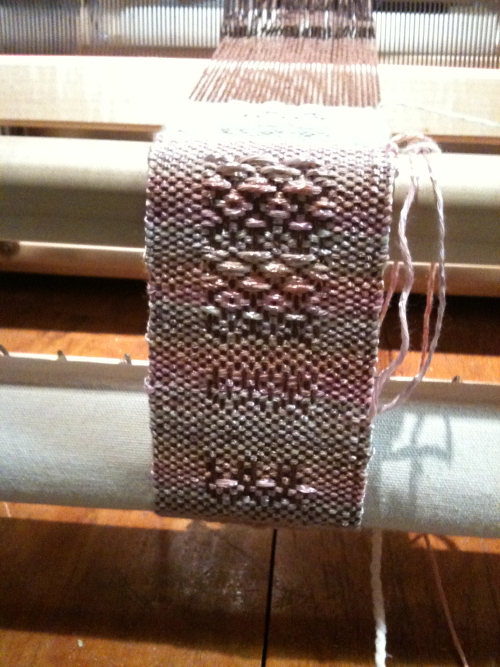
Again, the weft dominated. For this, I tried (completely)
different yarn — a wool of finer gauge:
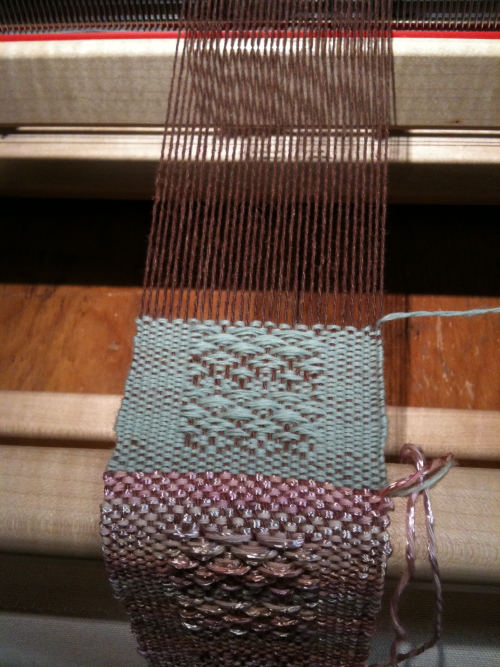
And, the experimentation continues. But, by the time I’m done
playing, and I have it off the loom and wet-finished, I will have a
very firm sense of what I want to do with my pinks and brown, and I’ll
have the confidence needed to plan and set up the project on the big
loom — a 10″ wide table runner is the plan.
And, I’ll start throwing more yarns on the Pioneer to see how
they work together 🙂
Well, you know that “one” is
an unstable number for looms, right? People who have one loom
either decide they don’t like weaving and get rid of it… or they are
hooked, and more follow…
